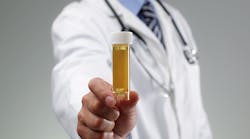The rate of workforce drug positivity hit a fourteen-year high in 2018, according to a new analysis released today by Quest Diagnostics .
Positivity rates in the combined U.S. workforce increased nearly 5% in urine drug tests (4.2% in 2017 versus 4.4% in 2018), climbing to the highest level since 2004 (4.5%) and are now more than 2% higher than the thirty-year low of 3.5% recorded between 2010 and 2012. The new findings of the Quest Diagnostics Drug Testing Index™ were unveiled on April 11 at the Drug and Alcohol Testing Industry Association (DATIA) annual conference in Chicago.
“Our in-depth analysis shows that marijuana is not only present in our workforce, but use continues to increase,” said Barry Sample, PhD, senior director, science and technology, Quest Diagnostics. “As marijuana policy changes, and employers consider strategies to protect their employees, customers and general public, employers should weigh the risks that drug use, including marijuana, poses to their business.”
Marijuana Dominates, Opiate Positivity Declines
Marijuana continues to top the list of the most commonly detected illicit substances across all workforce categories (general U.S. workforce; federally mandated, safety-sensitive workforce; and combined U.S. workforce, which includes the prior two populations) and specimen types (urine, oral fluid, and hair).
The rate of marijuana positivity increased in nearly all workforce categories. In the general U.S. workforce, marijuana positivity increased nearly eight percent in urine testing (2.6% in 2017 versus 2.8% in 2018) and almost 17 percent since 2014 (2.4%).For the federally mandated, safety-sensitive workforce, which utilizes only urine testing, marijuana positivity grew nearly five percent between 2017 (0.84%) and 2018 (0.88%) and nearly 24 percent since 2014 (0.71%).
In the general U.S. workforce, the positivity rate for opiates in urine drug testing declined across all opiate categories. Among the general workforce screening for opiates (mostly codeine and morphine), positivity declined nearly 21 percent between 2017 and 2018 (0.39% versus 0.31%), the largest drop in three years and nearly 37 percent decrease since the peak in 2015 (0.49%). Among the more specific tests for other prescription opiates, the positivity for the semi-synthetic opiates (hydrocodone and/or hydromorphone) declined two percent between 2017 and 2018 (0.51% vs. 0.50%) and 43 percent since the five-year high in 2014 (0.88%). Similarly, the positivity for oxycodones (oxycodone and/or oxymorphone) declined more than 29 percent between 2017 and 2018 (0.61% vs. 0.43%) and more than 46 percent since the five-year high in 2014 (0.80%).
Positivity Rates for Both Heroin and Cocaine Declined
Urine drug test results for the general U.S. workforce for heroin, indicated by the presence of the 6-acetylmorphine (6-AM) metabolite, declined six percent (0.033% in 2017 versus 0.031% in 2018) and more than 16 percent since its peak in 2015 and 2016 (0.037%). Cocaine positivity declined nearly seven percent in urine and more than 19 percent in oral fluid testing, but increased slightly year-over-year (6.3%) in hair testing.
Both heroin and cocaine positivity in the federally mandated, safety-sensitive workforce showed large declines between 2017 and 2018. Heroin positivity declined nearly 32 percent between 2017 and 2018 (0.019% versus 0.013%), with a decrease of more than 43 percent since 2015 (0.023%). 2018 positivity for cocaine declined nearly ten percent compared with 2017 (0.31% versus 0.28%), when the positivity rate was the highest in more than five years.
Changes to Federal rules for drug testing the federally mandated, safety-sensitive workforce went into effect in January 2018. The addition of four semi-synthetic opiates contributed to the large increases in year-over-year positivity among those workers. In 2018, testing for semi-synthetic opiates (hydrocodone and/or hydromorphone) and for oxycodones (oxycodone and/or oxymorphone), the positivity rate was 0.45 percent and 0.34 percent, respectively. These positivity rates are both slightly less than general U.S. workforce testing.
Increases in Post-Accident Positivity occur in both Safety-Sensitive and, General U.S. Workforce
In the federally mandated, safety-sensitive workforce, positivity for post-accident urine testing jumped more than 51% year-over-year (3.1% in 2017 versus 4.7% in 2018) and increased by nearly 81% between 2014 and 2018.
The jump in 2018 was largely driven by the addition of prescription opiates to the panel where the post-accident positivity for the semi-synthetic opiates (hydrocodone and/or hydromorphone) and for oxycodones (oxycodone and/or oxymorphone) was 1.1% and 0.77 percent, respectively. Post-accident positivity in the general U.S. workforce climbed nine percent year-over-year (7.7% in 2017 versus 8.4% in 2018), and 29 percent over five years. The post-accident positivity rate has risen annually since 2011 in the general U.S. workforce and since 2010 in the federally mandated, safety-sensitive workforce.
“Increases in post-accident positivity among safety-sensitive workers should serve as a warning to employers that employee drug use may increase the risk of workforce accidents or injuries,” said Kimberly Samano, PhD, scientific director, Quest Diagnostics. “Our analysis suggests that employers committed to creating a safe, drug-free work environment should incorporate strategies that monitor drug use above and beyond pre-employment drug screening.”
“Cheat the Test”
Findings show an increased percentage of urine specimens in both the federally mandated, safety-sensitive and general U.S. workforces reported as invalid due to inconsistency with normal human urine, suggesting attempts at specimen adulteration or substitution. Between 2017 and 2018, the percentage of invalid results in the federally mandated, safety-sensitive workforce jumped 80% (0.15% versus 0.27%), and 40% in the general U.S. workforce (0.15% versus 0.21%).
For an interactive map with positivity rates and trend lines by three-digit zip code in the United States, visit DTIDrugMap.com.



